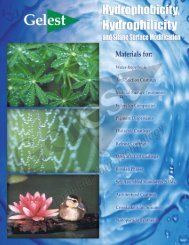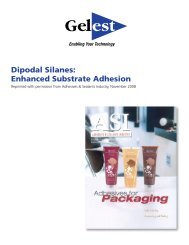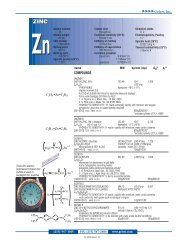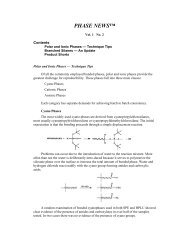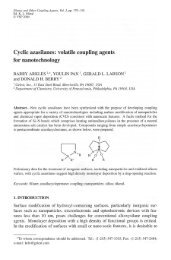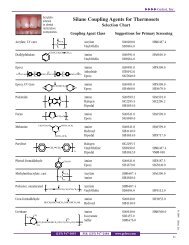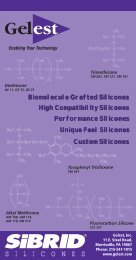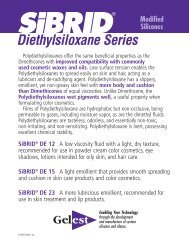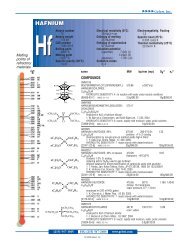Gelest Silicone Fluids - Gelest Inc.
Gelest Silicone Fluids - Gelest Inc.
Gelest Silicone Fluids - Gelest Inc.
Create successful ePaper yourself
Turn your PDF publications into a flip-book with our unique Google optimized e-Paper software.
▲<br />
▲<br />
▲<br />
▲<br />
Thermal <strong>Silicone</strong> <strong>Fluids</strong><br />
The thermal silicone fluids are described<br />
in chemical notation as aromatic<br />
siloxanes because of the presence of<br />
phenyl groups.<br />
High phenyl content fluids are utilized<br />
as heat-exchange fluids, dielectric<br />
coolants, impregnants for sintered metal<br />
bearings, and base oils for high temperature<br />
fluids. Low phenyl content fluids<br />
are utilized at lower temperatures than<br />
high phenylsilicones and find extended<br />
temperature service applications as<br />
lubricating oils for critical devices such<br />
as timers and systems involving rubber,<br />
plastic and aluminum mating surfaces.<br />
At elevated temperatures, and in the<br />
presence of oxygen, silicone polymers<br />
are subject to two types of degradation:<br />
R<br />
Si<br />
R<br />
O<br />
R<br />
Si<br />
R<br />
O<br />
Phenyl groups provide enhanced thermal<br />
properties by two mechanisms:<br />
1.Better protection of the chain<br />
Si—O—Si—O by steric hindrance.<br />
2. The lower susceptibility of the<br />
phenyl group to oxidative attack.<br />
As phenyl groups replace methyl groups<br />
in a polysiloxane, several changes occur.<br />
Oxidation resistance, thermal stability<br />
and shear resistance are enhanced. For<br />
polyphenylmethylsiloxane the service<br />
temperature is -55°C to 290°C. The gel<br />
time of several fluids is provided in the<br />
accompanying table. In closed oxygenfree<br />
systems the polyphenylmethylsiloxanes<br />
are stable for thousands of<br />
hours at 250°C. The materials are used<br />
in heating baths.<br />
The phenyl group also introduces rigidity<br />
in the silicone chain. When substitu-<br />
R<br />
Si<br />
R<br />
Oxidizing attack<br />
Thermal attack<br />
<strong>Gelest</strong>, <strong>Inc</strong>.<br />
Thermal <strong>Silicone</strong> <strong>Fluids</strong> for Mechanical and<br />
Heat Transfer Applications (Aromatic Siloxanes)<br />
DiPhenylsiloxane-DiMethylsiloxane Copolymers CAS: [68083-14-7]<br />
Viscosity, 25°C Viscosity, 99°C Viscosity Pour- Transition Gel time, hours<br />
Product Code cSt. cSt. Temp. Coeff. point, °C Temp., Tg °C 250°C in air*<br />
PDM-0421 100 29 0.62 -73 - 150-200<br />
PDM-0821 100-125 30-32 0.63 -70 - 1200-1500<br />
PDM-1922 160-230 26-28 0.78 -40 - 1500-2000<br />
PhenylMethylsiloxane-DiMethylsiloxane Copolymers CAS: [63148-52-7]<br />
PMM-1015 50 14 0.61 -70 -121 220-260<br />
PMM-1025 500 180 0.62 -70 -121 180-200<br />
PMM-1043 30000 5500 0.63 -70 -121 flashpoint**<br />
Tetrachlorophenylsilsesquioxane- Dimethylsiloxane Copolymers CAS: [68957-05-1]<br />
PTT-1117 70 18 0.68 -73 - 270-280<br />
* The gel time for conventional fluids (DMS-T31) is


